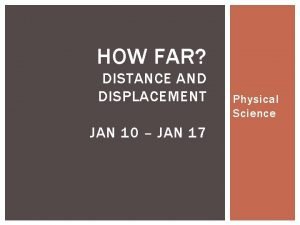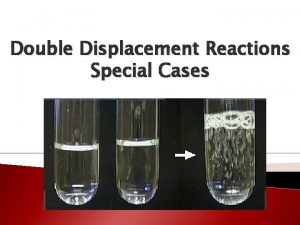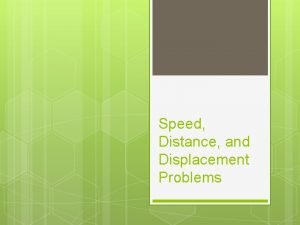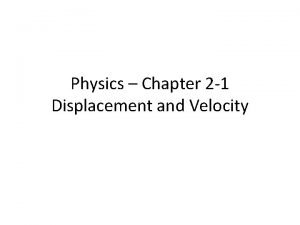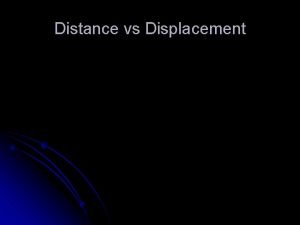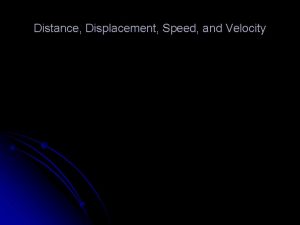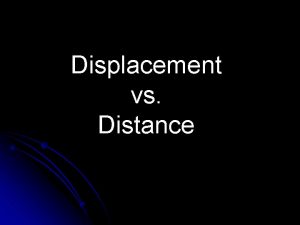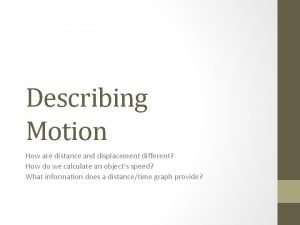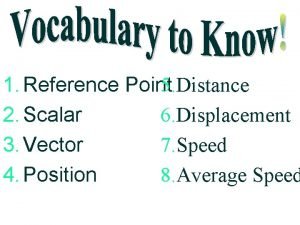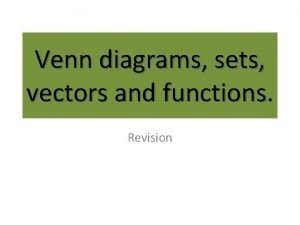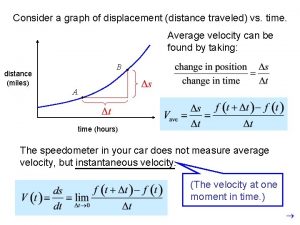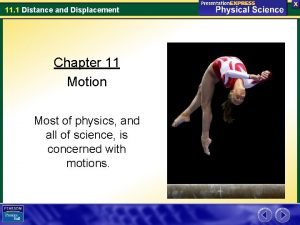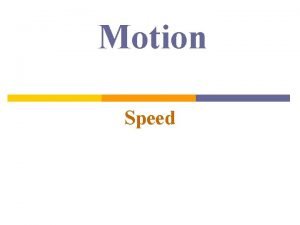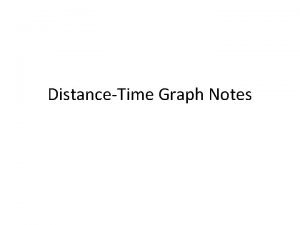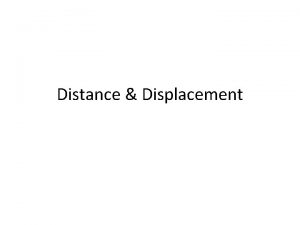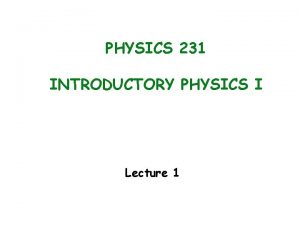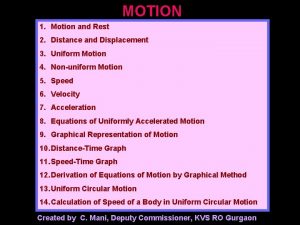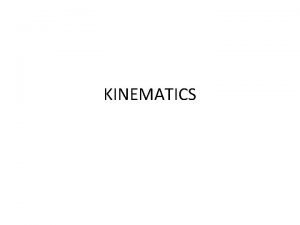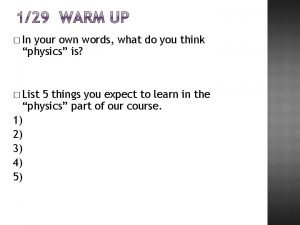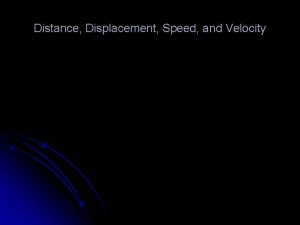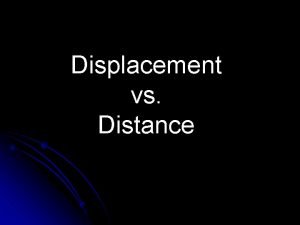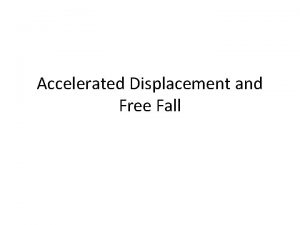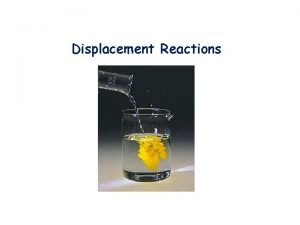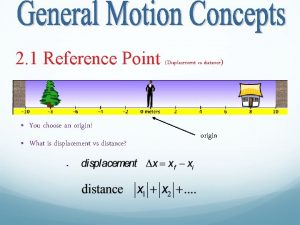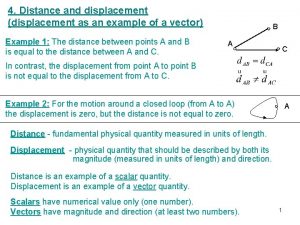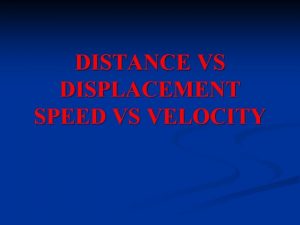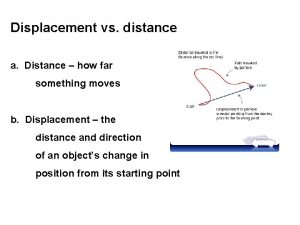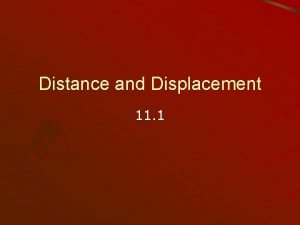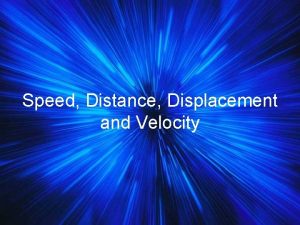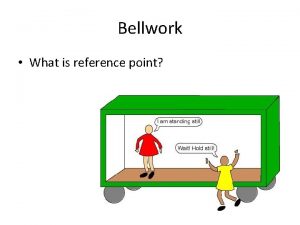2 1 Reference Point Displacement vs distance You
























- Slides: 24

2. 1 Reference Point (Displacement vs distance) • You choose an origin! • What is displacement vs distance? origin

2. 2 Velocity Average Velocity Units: or *1 m/s = 2. 24 mi /hr

2. 2 Velocity Average Speed Units: or *1 m/s = 2. 24 mi /hr

t Slope = + m/s

The Slope = m/s slope of a p-t graph shows velocity

t Slope = zero m/s

Pos v Neg v If the slope is increasing (+ or-) the quantity will increase : speed ! Pos v Neg v

2. 2 Velocity Instantaneous Velocity 0

It appears we have 2 different average velocities ! Nope. These are 2 separate instantaneous velocities. Slope = + m/s t

2. 4 Acceleration Average Acceleration Units: 2 2 2

v 0 t

t

v 0 t

Speeding Up then Slowing Down v t Slope= m /s 2

Slowing Down then speeding up v t Slope= m /s 2

Very rare to see in AP 1 v t

Substitute y for x if needed Substitute g for a in pure free fall

displacement as function of velocity (I) (II) Substitute (I) and (II) with t X= 1/2 (v+v 0) (v -v 0 / a)

displacement as function of time (I) (II) Substitute (I) and (II) with Vf X= 1/2 (v 0 + at + v 0)t 2

Shaded Area of v-t = displacement 1. The shaded area represent a velocity maintained for a certain time period. 2. If I went 2 m/s for 4 s then I went 8 meters. 3. The area of the graph = 8 m as well ! Why…. start with the units on the axes. . 4. Area= bh Area= (time)(velocity) Area= (s)(m/s)= meter

Shaded Area of v-t = displacement 1. This also calculates negative displacement as well… 2. If I went - 2 m/s from 2 s to 8 s I went - 12 meters. 3. That is due to the fact that I went -2 m/s for exactly 6 seconds 4. Area= b-h Area= (time)(-velocity) Area= (s)(-m/s)= -meter

Shaded Area of v-t = displacement 1. This also works for tringles 2. If I went from 0 m/s to 6 m/s in 4 secs…. . I went 12 meters. 3. That is due to the fact that I went an average of 3 m/s over the 4 second interv 4. Area= ½ bh Area= (time)(velocity) Area= (s)(m/s)= meter

Core Problem 1. 0 A particle is moving in the positive x dimension. Its position at any given time is given by the function: (x) t = 4 t 3 + 3 We will evaluate the particle as It changes through these time periods Dt = 0. 01 s, 0. 2 s, 0. 5 s, and 1. 0 s a) Calculate the particle’s position and fill in the table b) Calculate the particle’s average velocity t actual (s) position (m) Dt (s) v ave (m/s) Work :

 A delivery truck travels 18 blocks north
A delivery truck travels 18 blocks north Single displacement vs double displacement
Single displacement vs double displacement John drove south 120 km at 60 km/h
John drove south 120 km at 60 km/h Two students walk in the same direction
Two students walk in the same direction Distance vs displacement
Distance vs displacement Distance vs displacement
Distance vs displacement Displacement vs distance
Displacement vs distance How is distance different from displacement
How is distance different from displacement Is distance a scalar quantity
Is distance a scalar quantity Displacement is distance combined with
Displacement is distance combined with Set notation venn diagrams
Set notation venn diagrams Displacement vs distance traveled
Displacement vs distance traveled What is needed to describe motion completely
What is needed to describe motion completely Chapter 11 distance and displacement
Chapter 11 distance and displacement Distance vs displacement
Distance vs displacement Distancetime graph
Distancetime graph Displacement is a scalar measurement
Displacement is a scalar measurement Distance vs. displacement
Distance vs. displacement Distance vs. displacement
Distance vs. displacement Equation of motion graphically
Equation of motion graphically Distance vs displacement
Distance vs displacement Distance vs. displacement
Distance vs. displacement Distance and displacement examples
Distance and displacement examples Reference node and non reference node
Reference node and non reference node Reference node and non reference node
Reference node and non reference node
